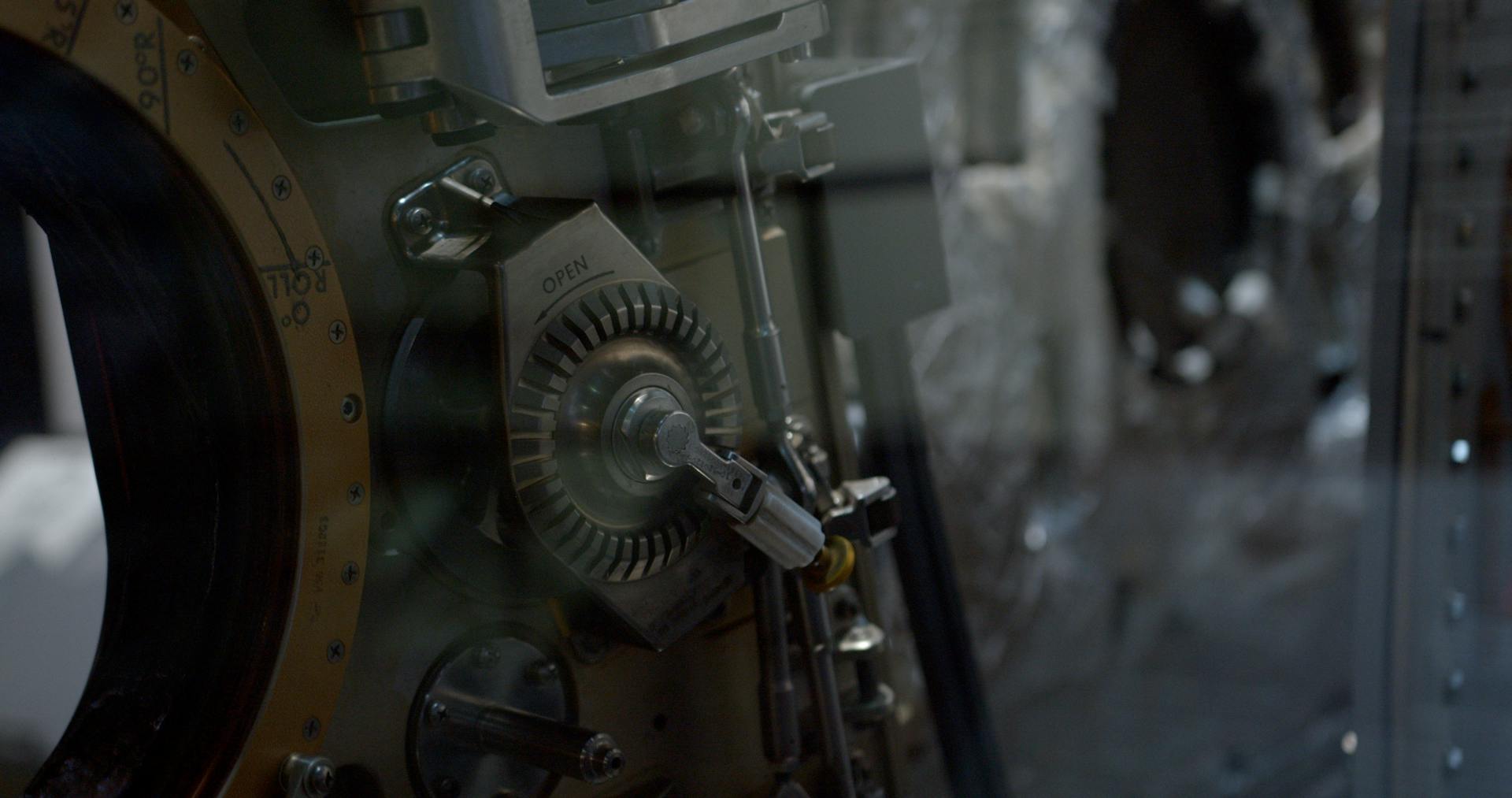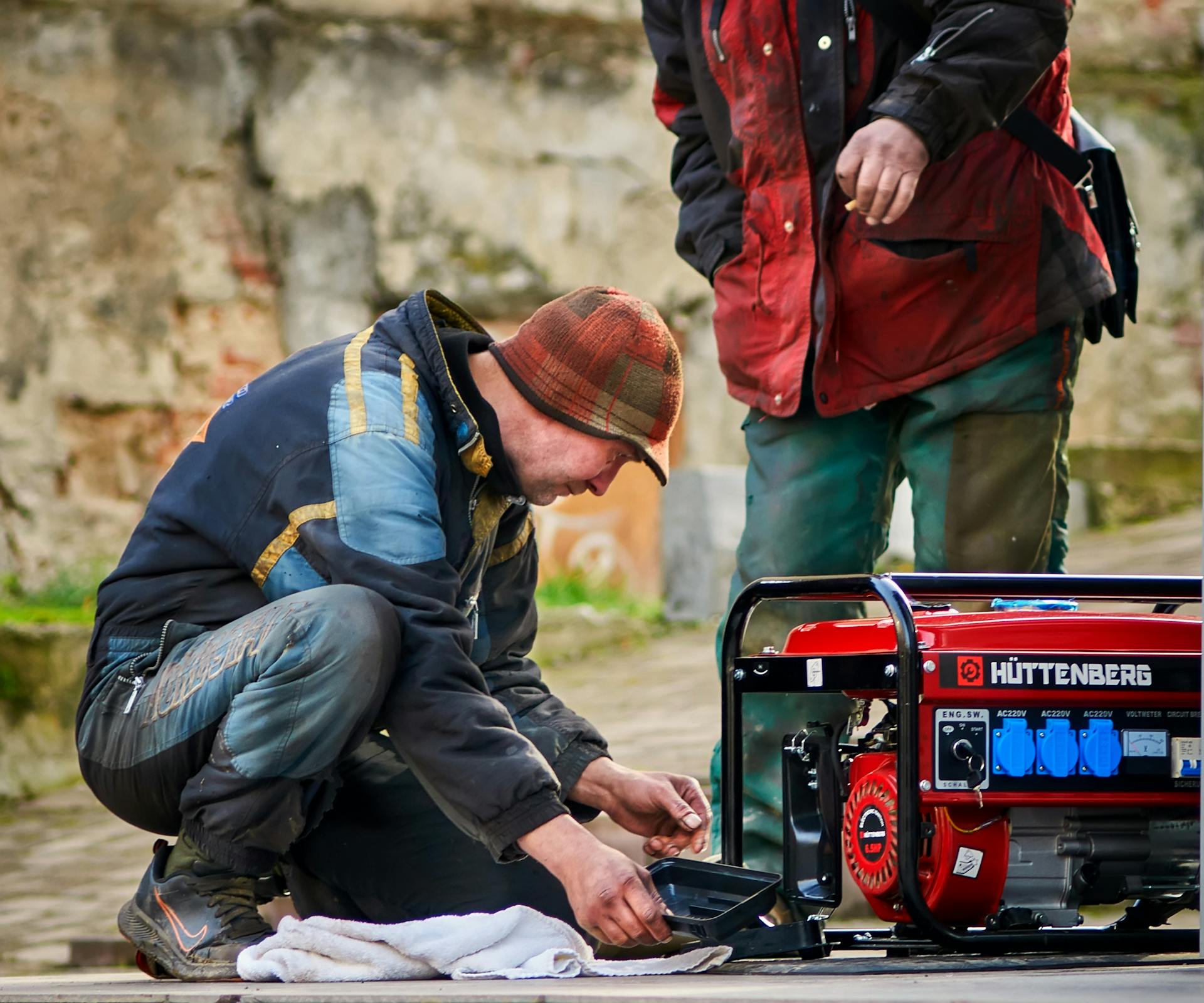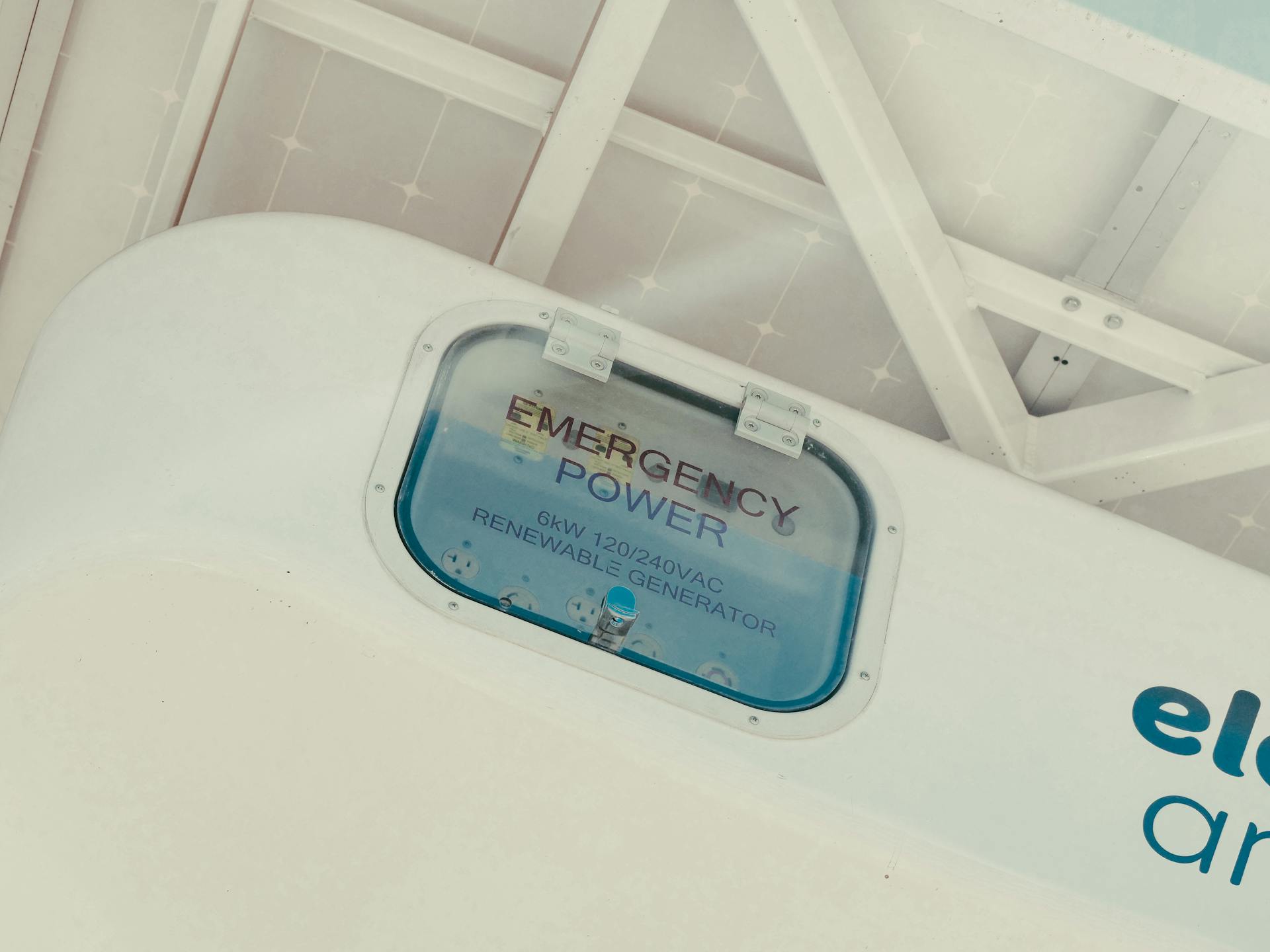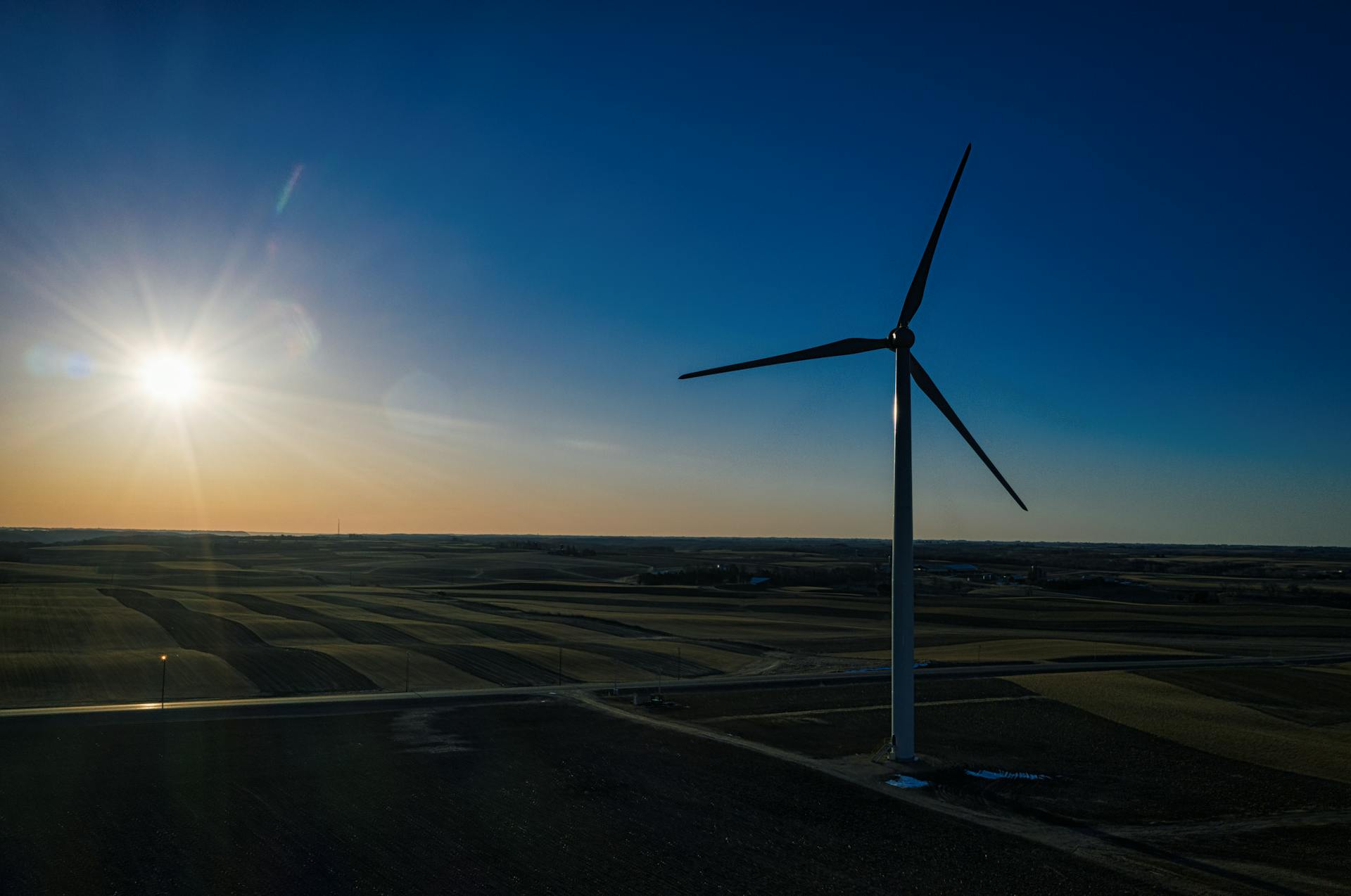
Induction generators are a type of electrical generator that produce electricity through electromagnetic induction. They are relatively simple to operate and maintain.
One of the key benefits of induction generators is their ability to produce electricity at a wide range of speeds. This makes them ideal for applications where the speed of the generator is not constant.
Induction generators can be powered by a variety of sources, including diesel engines, gasoline engines, and even renewable energy sources like wind and solar power.
Explore further: Does a Generator Produce Ac or Dc
Working Principle and Operation
An induction generator operates on the principle of electromagnetic induction. This means that it uses the interaction between magnetic fields to generate electricity.
The slip is a crucial concept in understanding how an induction generator works. It's the difference between the synchronous speed (Ns) and the speed of the rotor (N), given by the equation: Slip (s) = (Ns - N)/Ns.
The synchronous speed is the speed of the stator's revolving magnetic field, which depends on the supply frequency and the number of poles. The slip can be positive, zero, or negative, depending on the rotor speed.
Here's an interesting read: Permanent Magnet Synchronous Generator
When the rotor speed is lower than the synchronous speed, the slip is positive, and the rotor tries to catch up, generating torque. This is how an induction motor works.
At no load, the rotor revolves at or near synchronous speed, and the slip is zero. This results in no rotor current and no torque generated.
When the rotor speed is higher than the synchronous speed, the slip is negative, and the induction machine delivers power to the electrical load, operating as an induction generator.
Here's a breakdown of the slip:
- Positive slip: Rotor speed < Synchronous speed
- Zero slip: Rotor speed = Synchronous speed
- Negative slip: Rotor speed > Synchronous speed
The operation of an induction generator involves several steps. Initially, the induction machine stator is connected to the AC power supply, generating a revolving magnetic field (RMF) in the stator.
This RMF induces a current in the rotor, called rotor current, which flows in the short-circuited bars of the rotor and generates its own magnetic field, the rotor field. The rotor field interacts with the stator field and starts revolving in its direction.
Related reading: Direct Current Electric Generator
As long as the rotor speed is less than the synchronous speed, the machine acts as an induction motor, drawing power from the source.
To operate as an induction generator, the rotor speed needs to be increased using a prime mover to match the synchronous speed. At this point, the slip becomes zero, and there is no rotor current or torque generated.
Finally, the rotor speed is increased above the synchronous speed, resulting in a negative slip. The stator RMF starts cutting the rotor bars, generating rotor current in the opposite direction.
This rotor current generates its own magnetic field that opposes the stator RMF, causing the stator current to flow out of the stator winding against the applied voltage. At this point, the induction machine starts delivering power to the circuit connected to its stator, operating as an induction generator.
Discover more: Asynchronous Generator vs Synchronous Generator
Types of Synchronous Generators
Synchronous generators are often referred to as alternators and can be classified into two main types: brushless and brush-type.
The brushless type of synchronous generator uses a commutatorless design, which eliminates the need for brushes and slip rings.
This type of generator is commonly used in applications where high reliability and low maintenance are required, such as in wind turbines.
Brush-type synchronous generators, on the other hand, use a commutator and brushes to transfer electrical current from the rotor to the stator.
They are often used in smaller power generation applications, such as in diesel generators and small hydroelectric power plants.
In addition, synchronous generators can be further classified into sub-transient and transient types based on their response to sudden changes in load.
Sub-transient synchronous generators have a more stable response to sudden changes in load, making them suitable for applications where load fluctuations are common.
Transient synchronous generators, while more sensitive to sudden changes in load, are often used in applications where high power factor correction is required, such as in industrial power systems.
Grid and Stand-Alone Connections
Grid and stand-alone connections are two different ways induction generators can be set up. In a stand-alone system, a capacitor bank provides the reactive power needed to establish the air gap magnetic flux.
The air gap magnetic flux is crucial for the generator's operation. For grid-connected systems, the generator draws reactive power from the grid to maintain its air gap flux.
In stand-alone systems, the frequency and voltage are complex functions of machine parameters, capacitance used for excitation, and load value and type. This makes it more challenging to maintain a stable output.
The testing of stand-alone and grid-connected asynchronous generators is a critical aspect of ensuring their performance.
Here are some key differences between stand-alone and grid-connected systems:
- Stand-alone systems require a capacitor bank for reactive power
- Grid-connected systems draw reactive power from the grid
- Stand-alone systems have complex frequency and voltage dynamics
- Grid-connected systems are synchronized with the grid before generating power
Protection and Control
Protection is crucial in induction generators to prevent damage and ensure safe operation. There are a few necessary protections required.
One of these protections is the Reverse Power Protection Relay, which senses the direction of power flow and breaks the circuit when power flows in the reverse direction. This prevents the induction generator from drawing power when it's supposed to be delivering it.
Under/Over Speed Relay is another protection that's essential in induction generators. This relay disconnects the capacitors when the generator operates at under/over speed conditions to prevent over-excitation.
The Reverse Power Protection Relay is specifically used to disconnect the power to the induction generator when it starts operating as a motor. This is a critical function that prevents damage to the generator and the electrical system.
In summary, the Under/Over Speed Relay and Reverse Power Protection Relay are two important protections that help prevent damage and ensure safe operation of induction generators.
Advantages and Disadvantages
An induction generator has several advantages that make it a popular choice for various applications. It does not require synchronization with the main supply line, which means it can operate independently.
One of the key benefits of an induction generator is its robust construction, which requires less maintenance compared to other types of generators. Additionally, it has a higher energy density, meaning it can produce more power per unit size.
The speed of the prime mover driving the induction generator is not critical, as it can operate at speeds above synchronous speed without affecting its performance. This makes it a versatile option for various applications.
Here are some of the key advantages of an induction generator:
- Robust construction and low maintenance
- Higher energy density
- No synchronization required
- Can operate at speeds above synchronous speed
- Can run in parallel with other generators
On the other hand, induction generators have some disadvantages. One of the main limitations is that they cannot generate reactive power on their own, which means they need to draw reactive power from the grid. This can be a drawback in certain applications where reactive power is critical.
Another disadvantage is that the speed of the prime mover must be above synchronous speed for the induction generator to operate as a generator, otherwise it will operate as a motor. This can be a limitation in certain applications where the speed of the prime mover is not controllable.
Applications and Uses
Induction generators are often used in wind turbines and some micro hydro installations due to their ability to produce useful power at varying rotor speeds. They are mechanically and electrically simpler than other generator types, making them a reliable choice.
Induction generators are widely used in wind power generation, where the mechanical energy of the wind rotates the rotor at a high speed above the synchronous speed. This makes them suitable for variable wind speed operation.
In hydroelectric power plants, induction generators are used to convert the mechanical energy from flowing water into rotational energy, which is then converted into electrical energy. They can be used in both small-scale and large-scale power plants.
Rural areas often lack access to proper electrical grids, so induction generators are used to provide electricity. Several small-scale induction generator power plants are used to meet the energy demand in these areas.
Induction generators are also used in isolated power generation, such as in remote locations with no electrical grid, like mining sites or camping areas.
Here are some key applications of induction generators:
- Wind power generation
- Hydroelectric power generation
- Rural electrification
- Isolated power generation
They are also used to supply power to loads in remote areas with weak transmission systems.
Performance and Characteristics
Induction generators are known for their ability to operate at variable speeds, making them ideal for applications where the speed of the prime mover may fluctuate.
Their high efficiency is due in part to the fact that they can operate at a wide range of speeds, from as low as 150 RPM to as high as 3000 RPM.
Induction generators are also capable of producing power at a wide range of frequencies, from 50 Hz to 60 Hz, making them suitable for use in a variety of applications.
Their compact design makes them a popular choice for use in remote or rugged locations.
Torque vs Slip
Torque vs Slip is a fundamental concept in induction generators, and it's essential to understand how it affects performance. Indefinitely increasing torque doesn't lead to an indefinite increase in power generation.
The rotating magnetic field torque excited from the armature works to counter the motion of the rotor and prevent over speed because of induced motion in the opposite direction. This counter torque reaches a max value of torque, known as breakdown torque, before the operating conditions become unstable.
Ideally, induction generators work best in the stable region between the no-load condition and maximum torque region. This is where they can operate efficiently and produce maximum power.
As the speed of the motor increases, the counter torque reaches its max value, which is typically around 3% slip value. At this point, the generator produces full-rated power.
Here's a summary of the relationship between torque and slip:
In practice, this means that if the prime mover is unable to produce enough power to fully drive the generator, the speed will remain somewhere between 1800 and 1860 RPM range.
Rated Current
The rated current of an induction motor or generator plays a crucial role in determining its performance. It limits the maximum power that can be produced by the machine.
In a grid-connected system, the rated current is a key factor in determining the power output of the induction generator. The machine's windings have a maximum current rating that cannot be exceeded.
The rated current is also important when it comes to the reactive power required to establish the air gap magnetic flux. A capacitor bank is often connected to the machine to provide this reactive power.
In stand-alone systems, the rated current is critical in determining the frequency and voltage of the machine. The machine's parameters, capacitance, and load value all play a role in determining these values.
Limitations and Comparison
Induction generators have some limitations to consider. They can only operate independently for a short time, generating enough reactive power to function with a capacitor system.
If the load current exceeds the generator's capabilities, it will immediately stop producing power, requiring the load to be removed and the generator restarted with either an external DC motor or residual magnetism in the core.
One key difference between induction generators and synchronous generators is that induction generators don't require DC excitation.
Induction generators also require an external AC supply of fixed frequency to operate, and synchronization is not needed as no EMF is generated until it's connected to the line.
Limitations

Induction generators can't operate indefinitely, as they require a capacitor system to generate reactive power.
If the load exceeds the generator's capability, it will immediately stop producing power, requiring the load to be removed and the generator restarted.
Induction generators are load-dependent, meaning they can't be used alone for grid frequency control.
They're particularly well-suited for wind generating stations, where speed is a variable factor.
If an induction generator is to be used for grid frequency control, an external DC motor or residual magnetism in the core is required.
For your interest: Can a Ac Motor Be Used as a Generator
Comparison of Synchronous
Synchronous generators require d.c. excitation to operate, which is a distinct feature compared to induction generators.
One key difference is that synchronous generators need a d.c. excitation to produce an emf, whereas induction generators do not require this.
Synchronization of the generator is also required for synchronous generators, which means the generator must be connected to the line at the same frequency as the grid.
The frequency of the synchronous generator is not decided by the excitation voltage, unlike induction generators.
You might like: Inverter Generator Not Producing Power
Frequently Asked Questions
Why don't we use an induction generator?
Induction generators have a significant limitation: they can't generate reactive power, making them dependent on external power sources. This limitation often makes them less practical for use in certain applications.
What is the difference between induction generator and synchronous generator?
Synchronous generators can generate power at a predetermined power factor, while induction generators draw reactive power from the grid to create excitation
Sources
- https://en.wikipedia.org/wiki/Induction_generator
- https://www.electricaltechnology.org/2024/04/induction-generator-asynchronous-generator.html
- https://www.tutorialspoint.com/induction-generator-asynchronous-generator
- https://eee.poriyaan.in/topic/induction-generators-10250/
- https://www.wikiwand.com/en/articles/Induction_generator
Featured Images: pexels.com


